To address the error you see:
SyntaxError: JSON.parse: Unexpected character at Line 1 Column 1
The JSON.parse() method parses a JSON string, constructing the JavaScript value or object described by the string. You are feeding it a URL when it is expecting [ or { as the first character. So h causes a Syntax Error.
Assuming you define the Object jsTrips someplace in your code, and this is a more basic object, I would suggest the following:
$(function(){
console.log("Start jsTrips");
var i = 0;
$.each(jsTrips, function(k, v){
if(i >= 2){
$.getJSON("http://localhos:8080/trips/" + v, function(data_file){
$("." + i).html(data_file.start_time);
});
}
i++;
}
console.log("Finished");
});
This code also assumes there are HTML Elements with attributes like class="2". It would be better to update your Post with an example of the Objects and an example of the JSON being returned.
Now, if the Index of the Object is the class name, then it might look more like:
$.getJSON("http://localhos:8080/trips/" + v, function(data_file){
$("." + k).html(data_file.start_time);
}
Again, need to know what you're sending and what you expect to get back.
jQuery.getJSON() Load JSON-encoded data from the server using a GET HTTP request.
See More: https://api.jquery.com/jquery.getjson/
Update
Now using JSONP method via $.getJSON(), this will help address CORS:
$(function() {
var jsTrips = {
2: "file-1.json",
3: "file-2.json",
4: "file-3.json"
};
console.log("Start jsTrips");
$.each(jsTrips, function(k, v) {
var url = "http://localhos:8080/trips/" + v;
console.log("GET " + url);
$.getJSON(url + "?callback=?", function(json) {
$("." + k).html(json.start_time);
});
});
console.log("Finished");
});
<script src="https://cdnjs.cloudflare.com/ajax/libs/jquery/3.3.1/jquery.min.js"></script>
As you can see, this builds the new URL from your jsTrips as expected. You can get the start_time from the JSON directly. You don't need to parse it when JSON is expected.
In regards to the new CORS issue, this is more complicated. Basically, you're not calling the same URI so the browser is protecting itself from outside code.
Cross-Origin Resource Sharing (CORS) is a mechanism that uses additional HTTP headers to tell a browser to let a web application running at one origin (domain) have permission to access selected resources from a server at a different origin. A web application makes a cross-origin HTTP request when it requests a resource that has a different origin (domain, protocol, and port) than its own origin.
An example of a cross-origin request: The frontend JavaScript code for a web application served from http://domain-a.com uses XMLHttpRequest to make a request for http://api.domain-b.com/data.json.
For security reasons, browsers restrict cross-origin HTTP requests initiated from within scripts. For example, XMLHttpRequest and the Fetch API follow the same-origin policy. This means that a web application using those APIs can only request HTTP resources from the same origin the application was loaded from, unless the response from the other origin includes the right CORS headers.
See more: https://developer.mozilla.org/en-US/docs/Web/HTTP/CORS & https://www.sitepoint.com/jsonp-examples/
If you are unable to change the port being used for the target JSON files, which I suspect is creating the CORS issue, you can consider using JSONP method versus GET method. Comment and let me know if this is the case, and I can update the answer. Example included in update.
Hope that helps.
